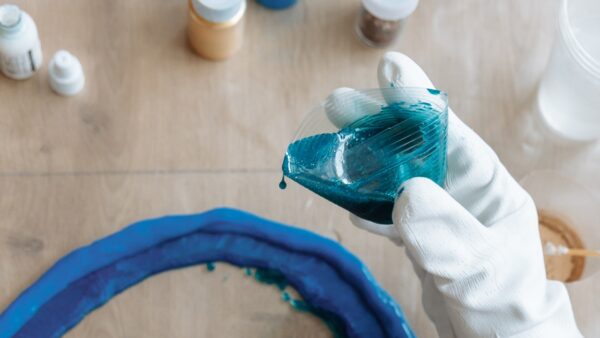How To Paint On Resin: 13 Expert Tips ☑
Welcome to your pro guide for painting on resin! Whether you’re a seasoned artist looking to enhance your skills or a beginner eager to explore the world of resin art, you’ve come to the right place.
With this guide you can begin to make 3D resin paintings and layering techniques by painting on resin. If you are new to resin, you might want to check out how to work with resin first, then come back to read this guide.
Painting on resin can be a unique and rewarding artistic experience, and this guide is here to give you with some tips to help you get good results after your resin is cured.
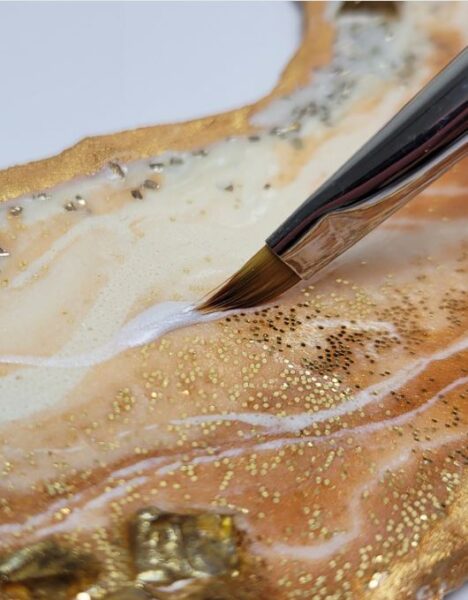
Painting on resin can be challenging. By the end of this guide, you’ll have pro knowledge on how to make the most of this versatile medium. Let’s dive in and discover the best ways to paint onto resin.
How to Paint On Resin
1. Surface Preparation for the resin
Can you paint over resin? Yes, but take some steps first before painting epoxy resin. Surface preparation in resin painting is a first step. Clean the cured resin surface to remove any dirt, dust, or oils that might interfere with paint adhesion first.
This can be done by wiping the surface with a slightly damp, lint free cloth or wipe to make sure it’s clean and ready for painting.

Additionally, lightly sanding the resin with an extra fine-grit sandpaper can create a textured surface that helps paint stick better, especially on smooth or glossy resin surfaces.
This clean and slightly textured surface provides a suitable base for the paint to adhere to, ensuring a more durable and visually pleasing result.
Your first layer of resin must be completely cured before going ahead with surface prep. If not, you will ruin the finish. If you are not sure how long it takes your resin to cure, check out our guide: Resin Cure Times
2. Primer Application
Primer application in resin painting involves applying a resin-specific primer to the surface before you start painting.
You can skip this option, but for larger pieces, you might find that when you are painting on the resin, it might not stick as you like.
Not all resin projects need a primer. This is totally up to you.
The need for a primer before painting on resin depends on several factors, including the type of resin you’re using, the surface you’re applying it to, and the type of paint you plan to use.
Here are some considerations:
Resin Type
Some resins are formulated to bond well with various surfaces, including paints. In such cases, you may not need a primer.
Epoxy resins, for example, often have good adhesion properties. However, it’s always a good idea to check the manufacturer’s recommendations for the specific resin you’re using.
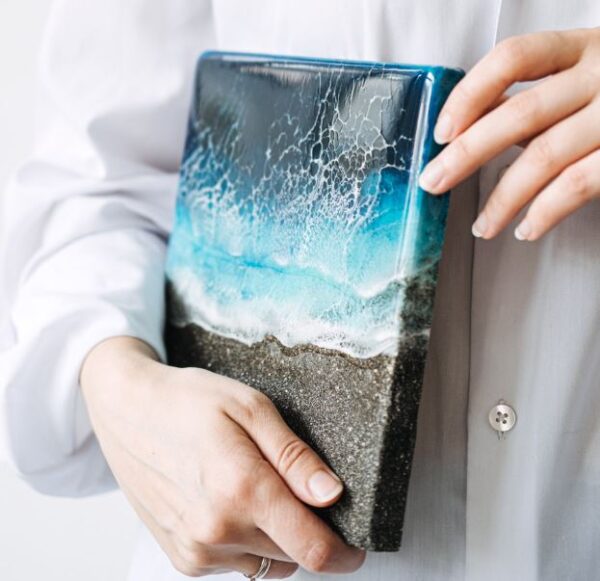
Paint Type
The type of paint you plan to use matters too. Acrylic paints for resin can adhere well to some resins and surfaces without a primer. We will go more into that below.
Project Specifics
Consider the specifics of your project. If you’re looking for a specific finish or effect, a primer can be useful. It can also enhance the durability of the paint over time.
It’s a good practice to perform a small test on a sample piece to make sure that your chosen combination of resin, surface, and paint adheres and behaves as desired. Some paints are way too thin and will not stick properly.
Following the manufacturer’s recommendations for the resin and paint you’re using is also advisable.
3. Sanding for Texture
Sanding for texture is a step in resin painting where you gently sand the resin surface using fine-grit sandpaper.
This creates a subtle texture on the surface, which can be particularly helpful when working with smooth or glossy resin surfaces. Learn all about how to sand resin in our guide.
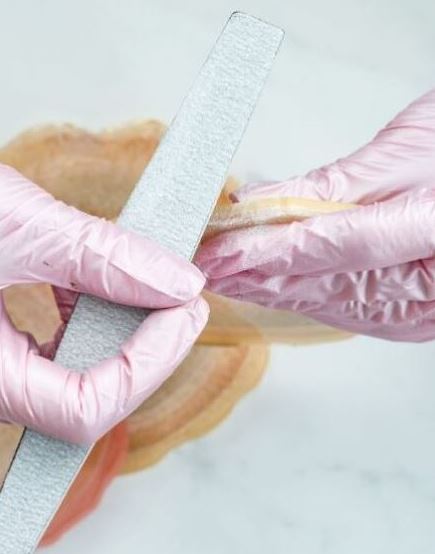
The textured surface provides a better grip for the paint, making it adhere more effectively.
This step is good for ensuring your paint bonds securely with the resin, preventing peeling or flaking, and helping to achieve a more professional and aesthetically pleasing finish in your resin artwork.
4. Paint Pens Will Work on resin
Paint pens are versatile tools for adding intricate details and precise designs to your resin art. These pens come in various tip sizes, allowing you to achieve both fine lines and broader strokes with ease.
They offer the convenience of a marker while providing the opacity and durability of paint. Paint pens work well on resin surfaces, allowing you to create sharp lines, vibrant colors, and intricate patterns.
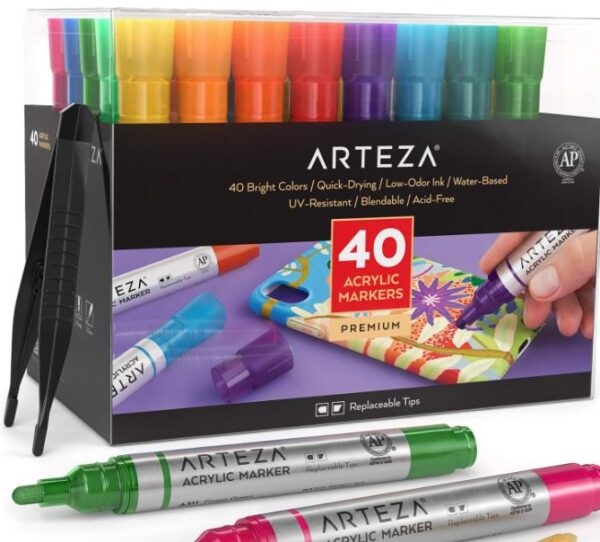
They’re particularly useful for adding bright details, signatures, or accents to your resin pieces, enhancing the overall aesthetics and uniqueness of your artwork.
5. Choosing the Right Paints for resin
Choosing the right paints for resin painting is a key decision in your creative process. Acrylic paints are the best for painting on resin because they work well with adhering to resin surfaces and will dry fairy quickly.
Acrylics paints are favored for their quick drying time, making them convenient for layering and blending. Choose a brand that has a thicker formula as resin is smooth so a runny paint will not work as well.
We have a helpful guide on the best acrylic paints for resin with more options that will work.
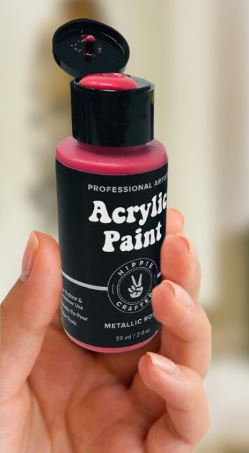
Selecting the appropriate paint type is essential for creating vibrant and long-lasting resin art. Some paints will fade over time so a lightfast paint will be preferred.
You can of course use oil based paints to paint on resin, but you are going to have to wait until the paint cures properly before going ahead with another layer. This process can take months to complete.
6. Multi Sized Brushes to paint on resin
A mixture of different sizes of brushes play a vital role in resin painting, allowing for precise and controlled application of paint on your resin surface.
Investing in good brushes will help them maintain their shape and provide you with smooth, even strokes.
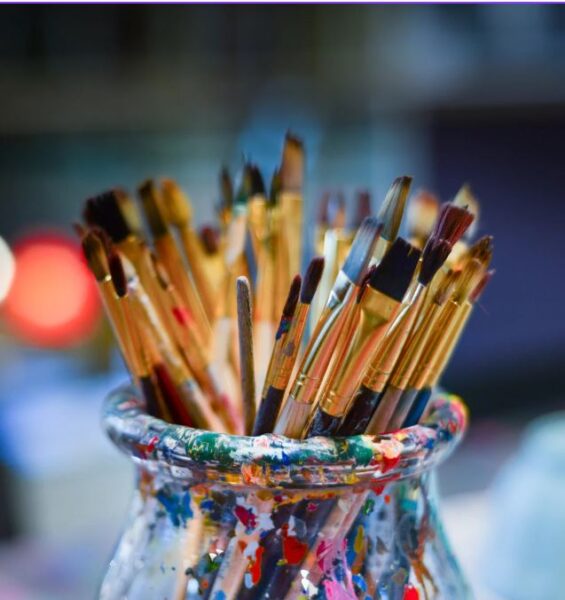
Synthetic brushes are often recommended for their durability and resilience, as they withstand the often harsh effects of resin better than natural bristle brushes.
With a good selection of brushes from fine liners to larger ones, you can achieve finer details, and make the overall painting process smoother and more enjoyable when you can reach for the right tools.
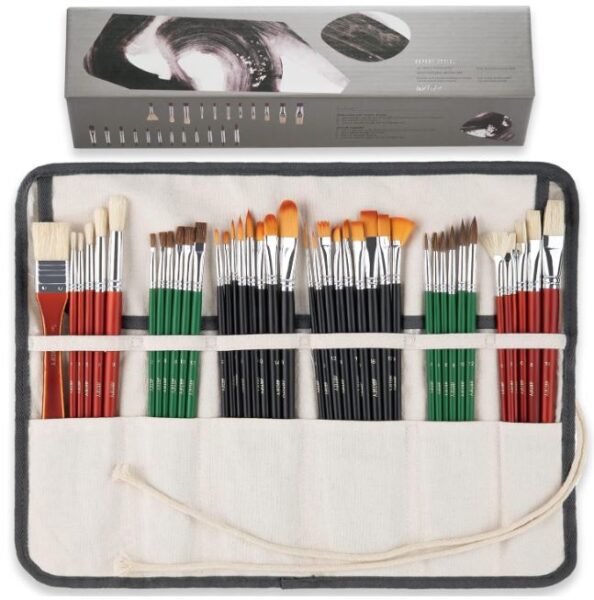
7. Seal the Surface before painting
Sealing the surface in resin painting involves applying a clear coat of resin over your base layer of artwork.
This clear coat serves to encase and protect your painting, as well as enhancing its overall finish. And if you are painting 3D, then you will be pouring lots of layers in between the paint.
It helps to secure subsequent layers of paint by providing a sealed surface for the paint to adhere to, ultimately ensuring the longevity of your artwork.
The sealing process often imparts a glossy and polished appearance to your resin art.
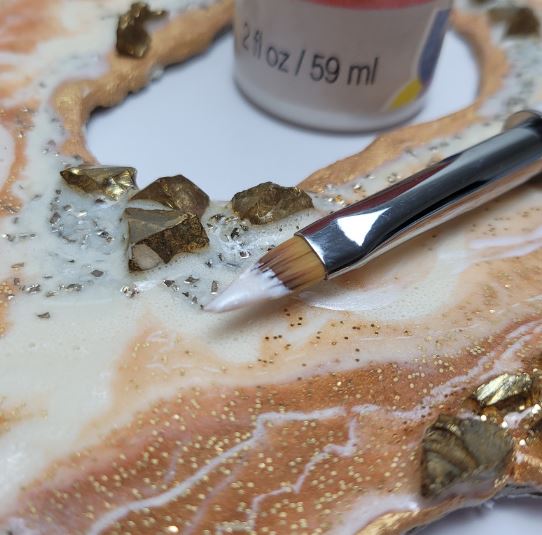
By sealing the surface with a coat of resin, you create a protective barrier. It makes everything super shiny and safeguards it from things that could potentially harm or degrade the quality of your resin painting over time.
Adding a resin coating will also level out the surface which is especially important if you are painting on accents to things like epoxy resin flower trays.
8. Layering Technique for painting
Layering technique in resin painting is a method where you apply paint in multiple layers, starting with lighter colors and gradually building up to darker ones.
This process is essential for achieving the desired depth, dimension, and color vibrancy in your artwork. By beginning with lighter shades, you maintain the intended color intensity and texture.
Each layer must be allowed to dry completely before adding the next to avoid mixing and muddying of colors.
Layering allows for intricate and complex designs, enables you to blend colors more effectively, and is a fundamental approach for resin artists to create striking and visually captivating pieces of art.
9. Mixing Mediums for paints
Experimentation with acrylic mediums, such as glazing liquid, can open doors to distinctive effects in your resin painting.
These mediums extend the drying time of your acrylic paints, enabling you to refine intricate details and transitions between colors.
They also aid in achieving smoother gradients and blends for a harmonious visual appeal.
10. Patience with Drying
Resin painting is a medium that demands patience. Allow each layer of paint to dry thoroughly before progressing to the subsequent layer.
Rushing this process can result in colors inadvertently mixing and muddying, potentially compromising the overall quality and depth of your artwork. Also, you risk the resin not curing properly.
11. Paint Thin Layers Onto The Resin
When applying paint to a resin surface, strive to employ thin, even layers. Thin applications are less prone to forming unsightly goops and are instrumental in preserving the transparency and luminosity of the resin.
Painting on multiple thin layers will help you with precise control over color intensity and making the paint look like it’s floating in the resin.
12. Experiment with Various Materials
Experimenting with various materials in resin art is one of those things that are fun to do. You never know what you can really do unless you are constantly trying out new things. Sometimes it will work out, and other times not so much!
One time, I was making geode resin art and I was trying to mix some gold paint into the resin. Well I added too much and it caused the resin to totally seize up. Now I make sure that I only add a bit at a time. Plus now, everything is written down in a planner so I can go back on notes.
In addition to traditional paints, you can check out a wide range of materials to introduce unique textures and effects into your resin artwork. One thing that is really popular right now are resin pastes.
Consider incorporating things like inks, mica pigments for resin, metallic powders, glitters, dried flowers, or even mixed media techniques.
These materials can add depth, dimension, and visual interest to your resin pieces, making them more captivating and distinct.
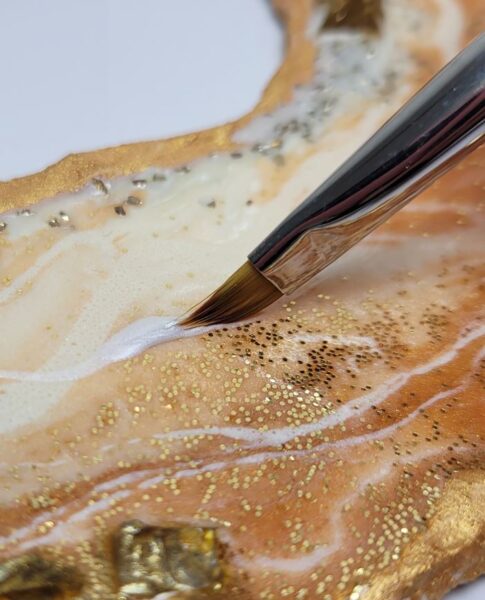
By experimenting with different materials, you have the opportunity to discover new artistic possibilities and create one-of-a-kind resin art that reflects your personal style and creativity.
13. Protect from Dust
Protecting your resin painting from dust is an important consideration in the resin art process.
Dust particles can settle on the wet or drying resin surface, leading to unwanted imperfections.
To safeguard your artwork, keep your working area as clean as possible during the painting and curing stages.
Maintaining a dust-free workspace helps so that that your final piece remains smooth and blemish-free, allowing the true beauty of your resin art to shine through.
Painting On Resin: FAQ
How do I prepare a resin surface for painting?
Start by cleaning the surface to remove dust, debris, or oils. Consider using isopropyl alcohol and, if needed, lightly sand the surface for better paint adhesion.
How do I prevent air bubbles in my resin painting?
To minimize air bubbles, make sure to mix your resin thoroughly and avoid excessive stirring. Using a torch or heat gun to remove bubbles on the surface is also a common practice.
We have a helpful guide about resin bubble removal.
Can I paint resin without priming it first?
Yes. While it is possible to paint on resin without priming it first, using a primer is generally recommended for better results on larger pieces.
Priming serves several purposes, such as improving paint adhesion, creating a smoother surface, and reducing the risk of flaking or peeling.
The good news is that there is no right or wrong way to do this, it’s just a matter of preference and what works for you!
In Closing: Thank you for taking the time to read and explore these insights on resin art. We hope you found this information helpful and inspiring for your creative journey. If you have any more questions or need further assistance, please don’t hesitate to ask. Happy creating!
For some inspiration, we will leave this video here showing you some amazing artwork of painting on resin and what can be accomplished. Have fun and practice lots!
Work with resin safely
Resin often emits fumes that can be unpleasant or even hazardous in poorly ventilated spaces.
To address this, working in a well-ventilated area, such as a room with open windows or an exhaust system, helps dissipate these fumes, protecting your health.
Wearing a respirator mask designed for chemical fumes is another essential precaution when handling resin in enclosed or inadequately ventilated spaces, further ensuring your safety while working on resin art projects.
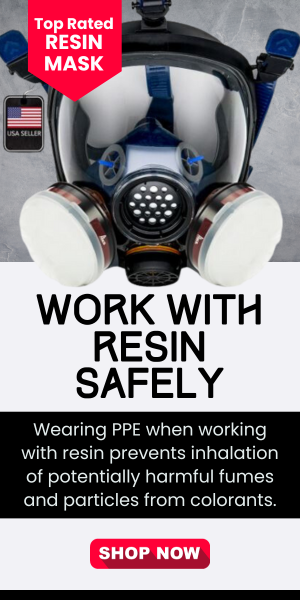

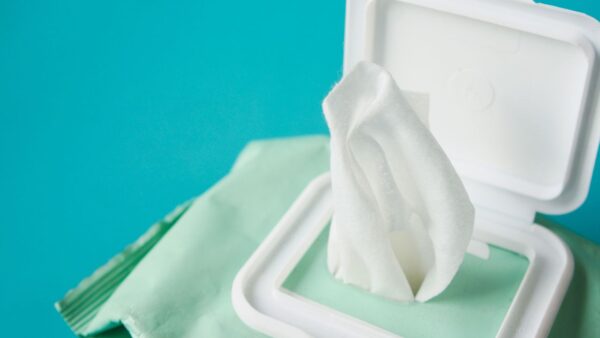
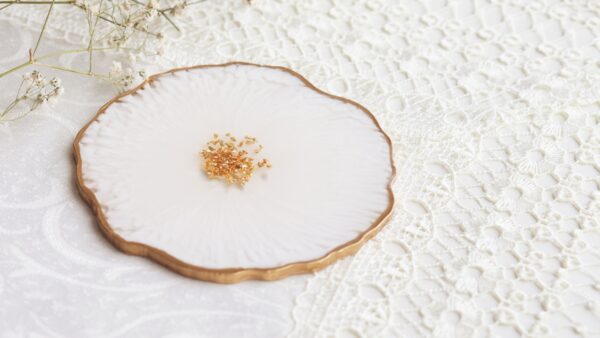
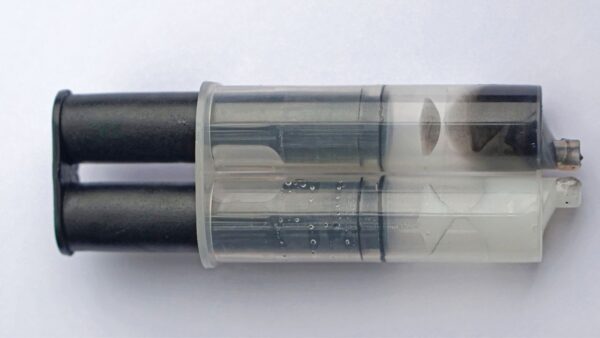
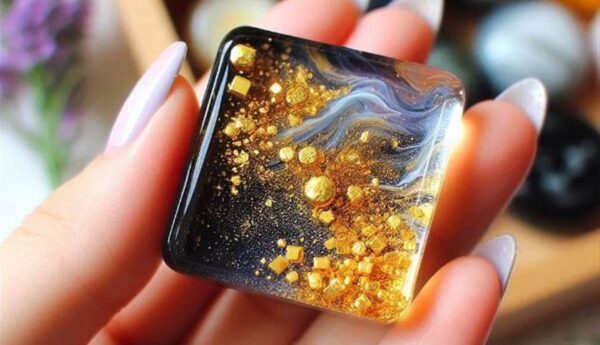
![How To Get Resin Off Of Hands & Skin [Don’t Use Chemicals]](https://craftydiyartistry.com/wp-content/uploads/2024/01/how-to-remove-resin-from-skin-cover-600x338.jpg)
